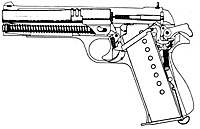
We invited Ian Hogg to describe the background to this major new reference work:
Some years ago I had occasion to require some figures on the well-documented German Gewehr 98 rifle. So I reached up to my reference shelf, took down a book, looked up the figures and jotted them down. Then, for no particular reason, I looked them up in another reference book. And got a different set of answers. This led me to a third, a fourth and a fifth, at which point I gave up because it seemed obvious to me that subsequent books had merely copied one or other of my original choices.
Study of five different reference works informed me that the length of the rifle was 49.2, 49.21, 49.25 or 49.4 inches; that the barrel was 29.10, 29.13 or 29.15 inches long; that the rifle weighed 8.81, 9.0, 9.1 or 9.5 lbs; and that the muzzle velocity was 2099, 2530, 2850, 2854 or 2882 feet per second. In desperation I went out to see a friend of mine who owns a Gewehr 98, borrowed his wife's kitchen scales and tape-measure and made my own mind up (except for the velocity; she wouldn't stand for that).
We small arms writers are, generally, a lazy lot; if we need the muzzle velocity of the Schmidt-Rubin M1911 we simply look it up in the first likely source to hand. And if we misread it or slip up in typing and put down 2685 instead of 2865, nobody is likely to argue with it. And the next chap who wants the velocity will take down the latest book and copy the figure, and away we go. And not only figures; there are a few weapons which reappear in descriptive books from time to time which, diligent research has shown, simply never existed.
As a result of all this, and more similar experiences, when Lionel Leventhal asked me for a small arms data book I saw the way clearly in front of me: start from scratch, take the figures from authoritative sources (official handbooks, manufacturers' drawings) or go out, find the weapon, and do some measuring. It took time, it produced some startling answers, and it added up to a lot of pages, but we got there in the end (I say 'we' by way of acknowledging the vital part played by Donald Sommerville, the sub-editor, who turned slabs of typescript into a good-looking book). There is little pretension to artistry – a handful of pictures to illustrate the various descriptive terms used – but a wealth of solid information all based upon the best possible source that I have been able to find. So for each military weapon – pistol, submachine gun, rifle or machine gun – of the metallic cartridge era there is a brief description followed by the figures for length, weight, barrel length and rifling, magazine or feed capacity and muzzle velocity. All the things you need to know, none of the flannel you don't want to know. There are also comparative tables in which weapons are arranged by calibre, so that it becomes easy to compare the dimensions and performance of, say, all 7 x 57mm rifles, or all 10.6 mm revolvers. Other pages give names and locations of manufacturers, a detailed 'Who's Who' of firearms worthies, tables of cartridge dimensions, a glossary of technical terms and a set of conversion tables from metric to imperial and vice versa.
And it works. Yesterday a friend who collects rifles rang me; he had acquired a mysterious rifle which had been lying in a cellar for sixty years and which had no maker's name on it. It looked like a Mannlicher. 'Bring it round,' I said, 'we'll see if this system works.' He produced the weapon; a quick check with half a dozen dummy cartridges soon identified the calibre as 7.92 x 57mm. We measured the overall length, and the barrel length, and weighed it. Then we entered the tables at the calibre, found the lengths, and there it was: a Chinese 1904 Mannlicher (and please don't ask me how it came to be in a Herefordshire cellar for all those years). But the point is that by using the Greenhill Military Small Arms Data Book we had the answer in three or four minutes.
I am, of course, making a rod for my own back here. Because inevitably, there are one or two weapons of which we know next to nothing and therefore cannot honestly include them, and, equally inevitably, experience tells me that there is bound to be an error somewhere in the multitude of figures, check and re-check as we may.
There are close on 1800 weapons listed, and there are nine items of information on each one – 16,200 figures. In that lot there are just 35 items marked 'not available'.
So, E & OE as the merchants used to say, I think we have put together a useful reference work which can be relied upon to produce the answer for 99.8 percent of the time.
Ian V. Hogg, a former editor of Jane's, is a respected authority on all aspects of weaponry and is the author of numerous books including German Artillery of World War II and German Secret Weapons of the Second World War. His The Greenhill Military Small Arms Data Book has 320 pages in the special format of 252 x 192mm and will be released this summer. It will be an exceptional reference work, effectively the distillation of Ian Hogg's compilation of detailed information over a career of many years.
Back to Greenhill Military Book News No. 91 Table of Contents
Back to Greenhill Military Book News List of Issues
Back to Master Magazine List
© Copyright 1999 by Greenhill Books
This article appears in MagWeb (Magazine Web) on the Internet World Wide Web.
Other military history articles and gaming articles are available at http://www.magweb.com